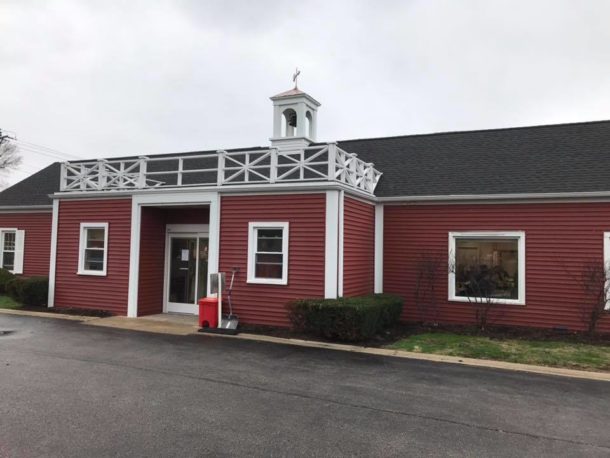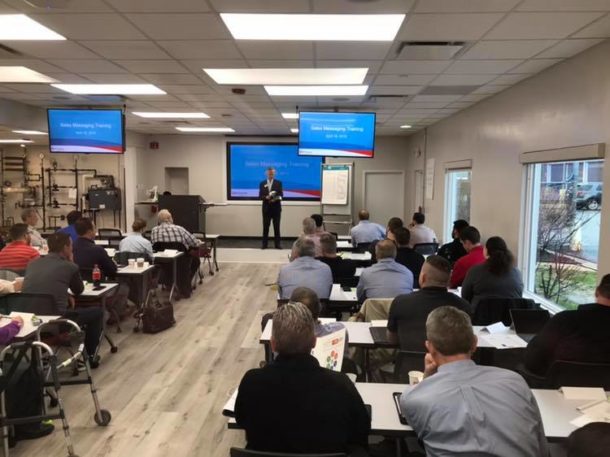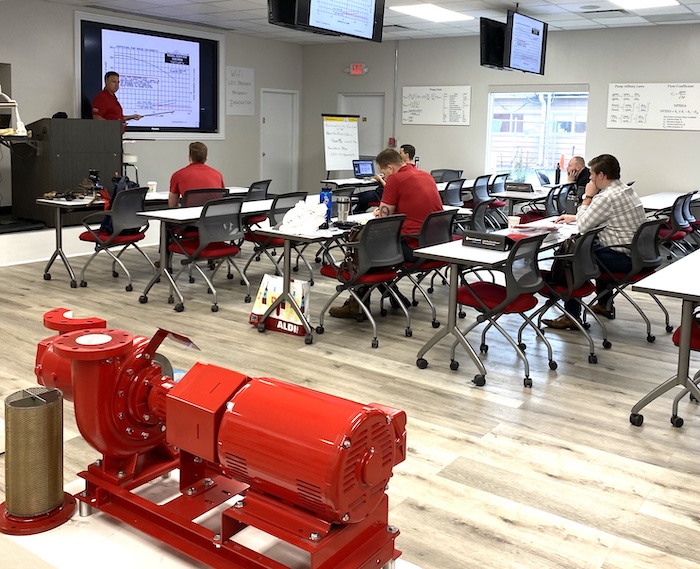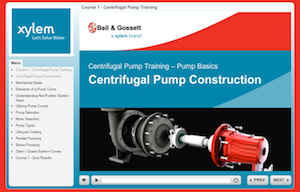Xylem Bell & Gossett recently reopened the Little Red Schoolhouse, the company’s suburban Chicago training center for professionals dedicated to the plumbing and hydronic HVAC industries. Xylem Bell & Gossett’s Little Red Schoolhouse in Morton Grove, Illinois, has been an industry icon in education for over 60 years, having trained more than 62,000 engineers, contractors Read more
Little Red Schoolhouse

Xylem Bell & Gossett recently reopened the Little Red Schoolhouse, the company’s suburban Chicago training center for professionals dedicated to the plumbing and hydronic HVAC industries.
Xylem Bell & Gossett’s Little Red Schoolhouse in Morton Grove, Illinois, has been an industry icon in education for over 60 years, having trained more than 62,000 engineers, contractors and other hydronic HVAC and plumbing professionals have been educated in the proper design, installation and maintenance of hydronic and steam systems.

The Little Red Schoolhouse offers training covering a wide range of seminars tailored to different occupations within the industry, and is accredited by the International Accreditors for Continuing Education and Training (IACET).
“Industry professionals recognize the value of in-person training, and we are happy to welcome them back to the Little Red Schoolhouse,” said Mike Licastro, director of training. “Whether it’s manufacturers’ representatives, engineers or contractors, our goal is for training to provide a knowledge base that makes them better equipped to perform their daily job duties related to hydronic and steam product application and system design.”
Instruction at the facility is well known for taking a systems-based approach that teaches students not only about individual components, but also how those components work together once installed in a complete plumbing and HVAC system.
Xylem Bell & Gossett, through the Little Red Schoolhouse, has a long history of providing industry professionals with the in-depth hydronic system design knowledge they need to confidently and expertly help their customers. The learning center was updated in 2019 to ensure Bell & Gossett’s mission of education continues to add value to and advance the industry.
Along with cutting-edge technology, Bell & Gossett has reinforced its emphasis on hands-on training with dedicated space for three new demonstration areas that feature functional displays of equipment for a variety of commercial and industrial applications, including variable speed controller technology, plumbing products and service and maintenance.

Little Red Schoolhouse second quarter schedule
- Design and Application* (April 26-29)
- Modern Hydronic Heating Systems – Basic Seminar* (May 10-12)
- Large Chilled Water System Design* (May 24-26)
- Plumbing System Design (June 7-9)
* Seminar approved by GBCI to provide credit toward the credential maintenance requirements of the LEED Associate and LEED AP certifications
To learn more about the Little Red Schoolhouse, enrollment, course descriptions and online courses, please visit www.bellgossett.com.

By Norman Hall Your new employee is in the job and doing great. You used a system, as mentioned in part 1, to introduce the employee to the company core values and team members. Now, how do you increase their value to your customers? By enhancing their knowledge. In this article we will walk through Read more
By Norman Hall

Mike LiCastro reviews pump curves at the Bell & Gossett Little Red School House.
Your new employee is in the job and doing great. You used a system, as mentioned in part 1, to introduce the employee to the company core values and team members. Now, how do you increase their value to your customers? By enhancing their knowledge. In this article we will walk through the system we use at R. L. Deppmann to train new hires on hydronic system design and product knowledge.
The Hydronic System Training Program – Step by Step
A perfect example to get us in the long-term training mindset is to think about the key educational stages in a medical career. Think of your long-term heating and cooling training program for employees as a series of steps. A basic overall “pre-med” program for hydronic system parts and pieces. Then you move to a “med-school” program where the employee learns a lot of detailed things needed in the job. A “residency” program allows them to use the knowledge with little supervision or oversite. This is where they may choose to become an expert in some area of interest.
Internally we refer to this program as our “Doctoral Program.” While not a formal official university program, this metaphor works well to help the new hire understand that they will increase their knowledge and expertise in stages
This outline for training may be used for any job classification: product salespeople, customer service, estimation, and even startup personnel. Let’s use an example of a startup technician.
The Start-up Technician Job Overview
- L. Deppmann (RLD) is a manufacturer’s representative. We startup pumps, boilers, steam condensate units, and packaged heat transfer and water heater systems. Our technicians do much more than a startup. We also get calls to assist contractors and plumbers in troubleshooting system issues. Obviously, the more seasoned technicians are more knowledgeable. What does their training program look like?
The Start-Up Tech ‘Doctoral’ Program
Part One: “Pre-Med.” Our technicians need to understand a great deal about how hydronic, steam, and plumbing systems work. This portion of training involves understanding the parts and pieces of each system and why they exist. This stage of training is done concurrently with the “hands-on” knowledge. The tech can be, for example, aligning pumps and basic startups most of the week. Their designated pre-med training happens just 4-6 hours per week. Most of it uses existing training programs internal to RLD or from other sources. One example is the Bell and Gossett Little Red Schoolhouse e-learning program.

As an example, let’s think of the air control portion of a hydronic system. This part one training would include “what they are” and “why they exist” for cold fill reducing valves, pressure relief valves, expansion tanks, air/dirt separators, and air vents.
This is the same knowledge an estimator or outside salesperson would need.
Part Two: “Med School.” This portion of the training plan really focuses on what can go wrong in the system or equipment as well as what can cause the issue. It now gets into the details of troubleshooting and servicing the equipment.
Keeping with the air control system example. How to set the cold fill pressure. How to replace an expansion tank bladder. Identifying the point of no pressure change issues.
This is where we introduce in-person classes at some of the manufacturers as formal training. An example is the Xylem Bell & Gossett Little Red School House in Morton Grove, Illinois. Once someone understands the basic what and why from part one, they are ready for the subject immersion of these classes.
“Med school” can go on for years depending on the number of opportunities to gain experience. Like gaining one’s medical degree, expertise in our industry is a marathon, not a sprint. The focus here is not on knowing how to do the day-to-day of one’s job, but rather mastery of their field. This takes time and patience.
Part Three: “Residency.” Now the Tech is ready to go beyond their basic job. Here they learn that trouble caused to one piece of equipment may be due to another. A true understanding of how everything interacts in the mechanical room. They are also able to train new people and customers at this point.
Using our air control example once again. How does a nuisance call about poor heating on the top floor lead the tech to check the cold fill pressure settings?
Multiple Concurrent Paths to Knowledge
Remember that an employee could be at multiple levels of knowledge at the same time. Someone could be done with air control med school knowledge while being in pre-med for steam and residency for boilers.
The team leader or manager is responsible for keeping “degree” records and identifying the order of subjects to be learned. This is a key success factor to the program. Knowledge and the ability to use it should be woven into employee accountabilities, reviews, one-on-one meetings, and even salary levels. The leader must understand the program and own it in order to seamlessly integrate it into the culture of their team and motivate employees to seek a higher understanding of their industry.
Your program will look different than mine. Any employee training program will help your company. You just need to commit to this fact: you cannot afford not to invest in new employee training.
 Norman Hall is an engineer and leader at the R. L. Deppmann Company, a manufacturer’s representative, in Michigan and Ohio. Norm has assisted in the design and troubleshooting of hydronic and steam systems for 45 years.
Norman Hall is an engineer and leader at the R. L. Deppmann Company, a manufacturer’s representative, in Michigan and Ohio. Norm has assisted in the design and troubleshooting of hydronic and steam systems for 45 years.

Bell & Gossett announces its 2015 third quarter Little Red Schoolhouse seminar schedule for in-person training. The training center’s seminars provide systems design training to engineers, wholesalers and contractors in the plumbing and hydronic heating and cooling industries. Little Red Schoolhouse Opened in 1954, the Little Red Schoolhouse offers seminars covering a wide range of Read more
Bell & Gossett announces its 2015 third quarter Little Red Schoolhouse seminar
schedule for in-person training. The training center’s seminars provide systems design training to engineers, wholesalers and contractors in the plumbing and hydronic heating and cooling industries.
Little Red Schoolhouse Opened in 1954, the Little Red Schoolhouse offers seminars covering a wide range of topics tailored to different occupations in the industry. Our Little Red Schoolhouse, a completely equipped learning center, has trained more than 60,000 engineers, contractors and installers in the proper design, installation and maintenance
of hydronic and steam systems.
Little Red Schoolhouse third quarter schedule
• Design & Application of Water Based HVAC Systems Seminar* September 28-30
• Service & Maintenance of Water Based HVAC Systems Seminar October 5-7
• Modern Hydronic Heating Systems- Basic Seminar* October 12-14
• Modern Hydronic Heating Systems- Advanced Seminar* October 19-21
• Design & Application of Water Based HVAC Systems Seminar* November 9-11
• Large Chilled Water System Design Seminar* November 16-18
• Steam System Design & Application Seminar December 7-9
*Seminar approved by GBCI to provide credit toward the credential maintenance requirements of the LEED Associate and LEED AP certifications
Online education
Bell & Gossett’s commitment to education continues with virtual curriculum. The Online Little Red Schoolhouse training and educational programming is available to a global audience. Programming begins with introductory courses on centrifugal pump fundamentals and piping systems. These courses are intended to complement the more in-depth, hands-on experience our students get through in-person courses.
For continuing education credit information, seminar descriptions, representative information and enrollment, visit www.bellgossett.com/training-education.
To sign up for seminars via the Online Little Red Schoolhouse, visit: http://training.bellgossett.com/.
